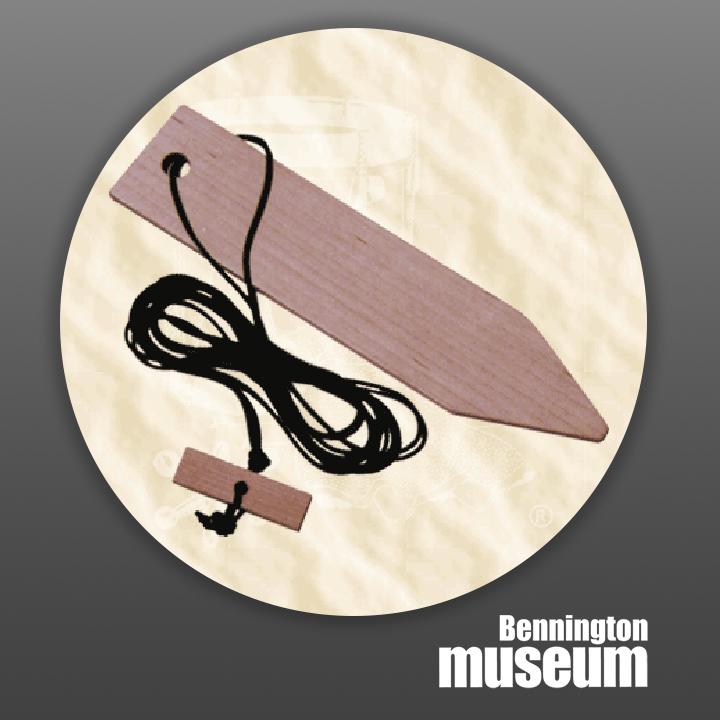Historic Folk Toys: Game, 'Bull Roarer'
Bull Roarer
Our Bull Roarer is made from 1/8-inch wood and is 7-1/2 inches in length with a handle attached to a braided nylon cord approximately four feet long. The Bull Roarer comes packaged with a brief history. It also is available with Native American packaging. See our Native American Bull Roarer. Swing the paddle overhead in a circular motion to hear the loud roaring noise of an angry bull. For outdoor use. Adult supervision is recommended.
Historical Background: The bull roarer is a primitive wind instrument and one of the first musical instruments Man invented. It has been used by primitive cultures in Africa, Australia, New Guinea, Europe, the Americas, and the Arctic polar region. Its origins can be traced to 24,000 years ago! It has been a symbol of fertility, and evidence of them has been found in several Paleolithic sites.
The bull roarer was an important acoustical part of various spiritual rituals and certain rites of passage in some areas of the world. When spun overhead in a circular motion, it produces a pleasing "whirr, whirr" hypnotic droning sound. This sound was incorporated into primitive rituals to produce a "voice" of an ancestor, a spirit, or deity. To others, its sound represented various insects and animals.
The bull roarer has been used for several purposes. It has been used to call out to the spirit world and to gain the attention of spiritual beings who were thought to be able to influence the natural elements, such as wind and rain. Hence, bull roarers are usually painted with various symbols representing clouds, raindrops, lightning, and other depictions. The Apaches in North America used bull roarers to call forth rain.
This ancient wind instrument was made with a flat wooden board (called a "rhomboid") and pierced with a small hole at one of the ends for attaching a length of cord or rope. The rhomboid was sometimes carved, painted, or both. Sometimes animal bone or stone was substituted for the flat wood board. Oftentimes, a thong handle was tied to the other end of the cord for a better grip to control speed and direction.
The bull roarer's sound is produced by vibrations of the flat wood as it rotates in the air. Changing in the speed and angle to the ground changes the sonority and allows an individual to make the sounds of a whimper, moan, roar, or scream.
There is not a typical range for bull roarers as each one is a one-of-a-kind instrument. Change the velocity of the spin, however, and the size of the instrument affects the relative pitch. The smaller the bull roarer, the faster it can be spun for a higher pitch. Conversely, a larger instrument spinning at a slower speed results in a lower pitch.
The bull roarer has been used by Native American cultures such as the Athabaskan, Nootka, Yokuts, Pomo, Hopi, and Aztecs. The Navajo call their bull roarers "Tsin di'ni" (groaning stick) and used them to drive away evil spirits. It is called several different names, including "Burliwarni," "Ngurrarngay," and "Muypak." Sometimes a bull roarer was used to send animals into ambush or to alert a tribe of another's presence in their area.
To the Maori, the bull roarer is called "Purererhua" (butterfly), and a smaller version (called a "Porotiti") was used for healing by spinning over areas of rheumatism or arthritis. (The sound's vibrations massaged joints in a similar way to modern ultrasound therapy!)
The main academics that have studied ancient bull roarers have been ethnomusicologists and anthropologists. This is because of the instrument's use in ritual and magic ceremonies.
Fun Fact: The bull roarer is also called a Rhombus and is still used today as the "voice of God" by Aborigine tribes in Australia!
Fun Fact: The bull roarer is an "aerophone" and, along with the flute, one of the oldest musical instruments of its kind!
PACKAGE DIMENSIONS - 4 x 8.5 x 0.5"
Our Bull Roarer is made from 1/8-inch wood and is 7-1/2 inches in length with a handle attached to a braided nylon cord approximately four feet long. The Bull Roarer comes packaged with a brief history. It also is available with Native American packaging. See our Native American Bull Roarer. Swing the paddle overhead in a circular motion to hear the loud roaring noise of an angry bull. For outdoor use. Adult supervision is recommended.
Historical Background: The bull roarer is a primitive wind instrument and one of the first musical instruments Man invented. It has been used by primitive cultures in Africa, Australia, New Guinea, Europe, the Americas, and the Arctic polar region. Its origins can be traced to 24,000 years ago! It has been a symbol of fertility, and evidence of them has been found in several Paleolithic sites.
The bull roarer was an important acoustical part of various spiritual rituals and certain rites of passage in some areas of the world. When spun overhead in a circular motion, it produces a pleasing "whirr, whirr" hypnotic droning sound. This sound was incorporated into primitive rituals to produce a "voice" of an ancestor, a spirit, or deity. To others, its sound represented various insects and animals.
The bull roarer has been used for several purposes. It has been used to call out to the spirit world and to gain the attention of spiritual beings who were thought to be able to influence the natural elements, such as wind and rain. Hence, bull roarers are usually painted with various symbols representing clouds, raindrops, lightning, and other depictions. The Apaches in North America used bull roarers to call forth rain.
This ancient wind instrument was made with a flat wooden board (called a "rhomboid") and pierced with a small hole at one of the ends for attaching a length of cord or rope. The rhomboid was sometimes carved, painted, or both. Sometimes animal bone or stone was substituted for the flat wood board. Oftentimes, a thong handle was tied to the other end of the cord for a better grip to control speed and direction.
The bull roarer's sound is produced by vibrations of the flat wood as it rotates in the air. Changing in the speed and angle to the ground changes the sonority and allows an individual to make the sounds of a whimper, moan, roar, or scream.
There is not a typical range for bull roarers as each one is a one-of-a-kind instrument. Change the velocity of the spin, however, and the size of the instrument affects the relative pitch. The smaller the bull roarer, the faster it can be spun for a higher pitch. Conversely, a larger instrument spinning at a slower speed results in a lower pitch.
The bull roarer has been used by Native American cultures such as the Athabaskan, Nootka, Yokuts, Pomo, Hopi, and Aztecs. The Navajo call their bull roarers "Tsin di'ni" (groaning stick) and used them to drive away evil spirits. It is called several different names, including "Burliwarni," "Ngurrarngay," and "Muypak." Sometimes a bull roarer was used to send animals into ambush or to alert a tribe of another's presence in their area.
To the Maori, the bull roarer is called "Purererhua" (butterfly), and a smaller version (called a "Porotiti") was used for healing by spinning over areas of rheumatism or arthritis. (The sound's vibrations massaged joints in a similar way to modern ultrasound therapy!)
The main academics that have studied ancient bull roarers have been ethnomusicologists and anthropologists. This is because of the instrument's use in ritual and magic ceremonies.
Fun Fact: The bull roarer is also called a Rhombus and is still used today as the "voice of God" by Aborigine tribes in Australia!
Fun Fact: The bull roarer is an "aerophone" and, along with the flute, one of the oldest musical instruments of its kind!
PACKAGE DIMENSIONS - 4 x 8.5 x 0.5"



